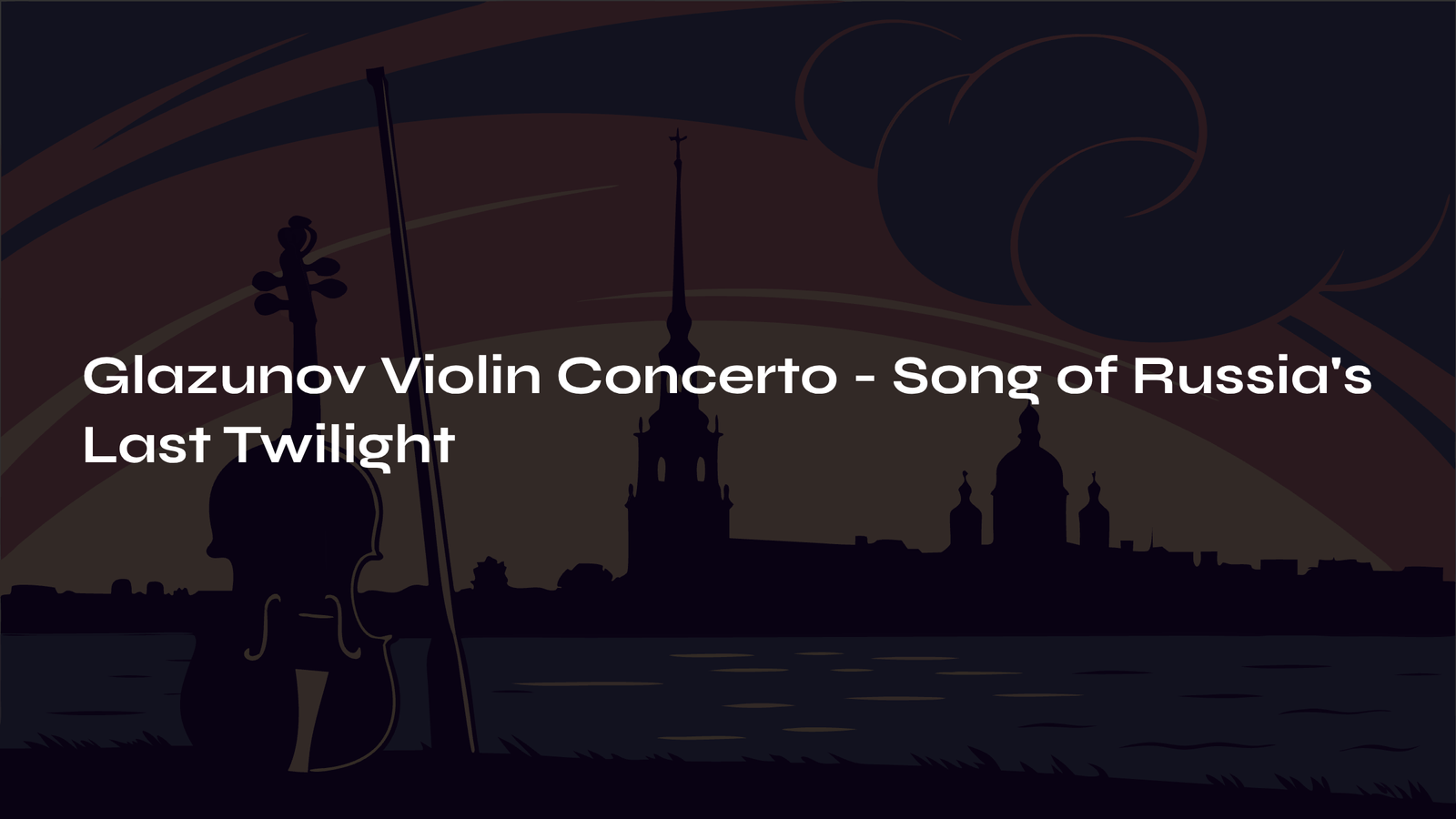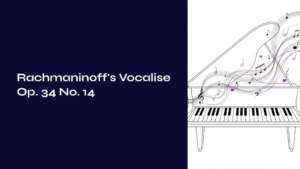Table of Contents

Like a Memory of Some Late Autumn Afternoon
Sometimes music travels back in time and takes us to a particular moment. Whenever I listen to Glazunov’s Violin Concerto in A minor, I find myself imagining a late autumn afternoon in St. Petersburg—a city I’ve never visited, in a time I’ve never experienced.
Yet the landscape that the music paints is startlingly vivid. The twilight seeping into the banks of the Neva River, warm candlelight spilling from palace windows, and enveloping it all, a melody so achingly beautiful it brings tears to your eyes. This is the gift that Glazunov left us in 1904.

A Flower Blooming Between Two Eras – Glazunov the Composer
Alexander Glazunov occupied a fascinating position in musical history. He was the last heir to the legacy of the Russian Five, while simultaneously standing at the threshold of 20th-century modernism. Born in St. Petersburg in 1865, he became Rimsky-Korsakov’s pupil at age 14, and his teacher marveled at his talent, saying his musical development progressed “not day by day, but literally hour by hour.”
Glazunov’s musical temperament was like the confluence of two rivers. On one side flowed the deep, folkloric emotions rising from Russian soil; on the other, the refined techniques and formal beauty of Western Europe. He didn’t force these elements together—rather, he allowed them to merge naturally.
It was no coincidence that he became director of the St. Petersburg Conservatory in 1905. He was uniquely positioned to balance tradition with innovation, nationalism with universalism. The fact that Shostakovich was later among his students speaks to his crucial role in Russian musical history.

Music Flowing Like an Epic Poem – The Secret of the Work’s Structure
The most captivating feature of Glazunov’s Violin Concerto is its unique structure. Though written as a traditional three-movement concerto, the movements flow continuously without breaks. It feels like reading a long epic poem, with one enormous narrative unfolding without interruption.
First Scene: A Time of Deep Contemplation (Moderato)
The concerto opens with a melancholy yet dignified melody in A minor. When the violin slowly presents the theme in its lower register, it feels like someone lost in deep thought, speaking to themselves. This theme carries all the hallmarks of Russian melody: broad, long-breathed phrases and an atmosphere tinged with sadness.
But soon the music reveals another face. The second theme, appearing in F major, is far more peaceful and lyrical. Like sunlight breaking through dark clouds, hope glimmers within the music.
Second Scene: Dreamlike Lyricism (Andante sostenuto)
This section, beginning in D-flat major, is perhaps the most beautiful moment in the entire concerto. As the violin floats dreamlike over melodies played by the woodwinds, time seems to stand still.
Here Glazunov’s orchestration shines brilliantly. The way the violin and orchestra converse is so natural and beautiful that you feel like you’re eavesdropping on lovers’ whispers. The deep emotionality characteristic of Russian music reaches its zenith here.
Third Scene: Passion and Reflection (Più animato)
The music begins moving again. But this isn’t simply fast music. The previously stated themes undergo various transformations, creating the feeling of life’s different moments passing by like a panorama. The violin’s virtuosic passages make their full appearance here, but they’re never merely showy—everything serves musical expression.
Fourth Scene: Fantasy of Russian Celebration (Allegro)
The finale shifts to A major, taking on a bright, festive character. Here Glazunov masterfully employs elements of Russian folk music. Particularly inventive is the section where the violin imitates the playing technique of the balalaika, a traditional Russian instrument. The sound effects created by combining left-hand pizzicato with harmonics evoke images of Russia’s vast landscapes.

The Echoes That Linger in My Heart
Listening to this concerto, I often think about music’s mysterious power of time travel. When Glazunov wrote this piece, was he already sensing the end of an era? 1904 was just one year before the Russian Revolution, and the beautiful culture of old Russia would soon be swept into the maelstrom of upheaval.
But perhaps that’s what makes this music even more precious. Like someone carefully placing their most treasured possessions in a jewelry box in their final moments, Glazunov condensed all the beauty of Russian Romanticism into this concerto.
Listening to the sonic magic created by violin and orchestra together, I often imagine: if memories had sound, they would sound like this. So beautiful it’s heartbreaking, so heartbreaking it’s beautiful.

Small Pieces of Advice for Deeper Listening
If you’re hearing this concerto for the first time, listen to it straight through without worrying about movement divisions. Just accept it as one long story—that’s exactly what Glazunov intended.
On your second listening, pay attention to the dialogue between violin and orchestra. Notice particularly how the woodwinds support the violin in the second movement, and feel that exquisite sense of balance.
Choice of performer matters too. Jascha Heifetz’s 1934 recording remains the benchmark for interpreting this work. In his performance, Russian emotionality and international sophistication achieve perfect harmony. Among contemporary performers, the interpretations of Maxim Vengerov and Vadim Gluzman are also excellent.

Music’s Eternal Message
Every time I listen to Glazunov’s Violin Concerto, I’m newly amazed by music’s mysterious power. That music composed 120 years ago still moves our hearts today, and will continue to do so in the future.
This concerto isn’t simply a succession of beautiful melodies. It’s the crystallization of an era’s spirit in musical form. Glazunov captured Russia’s last twilight in this music, and we can still feel that twilight’s beauty today.
Music transcends time. And sometimes it takes us to deep emotional places we didn’t even know existed within ourselves. Glazunov’s Violin Concerto is exactly that kind of music—music that reveals something new with each listening, music you can companion for a lifetime.

Next Destination: Mahler’s Symphony No. 1, 3rd Movement
After immersing ourselves in Glazunov’s lyrical beauty, a completely different world awaits us: Gustav Mahler’s Symphony No. 1, 3rd Movement “Funeral March.”
If Glazunov painted the last sunset of Russian Romanticism, Mahler anatomized the complex, contradictory spirit of fin-de-siècle Vienna through music. His third movement borrows the familiar melody from the fairy tale “Hansel and Gretel” and transforms it into a bizarre, ironic funeral march.
After Glazunov’s elegant sadness, we’ll encounter Mahler’s grotesque humor and profound despair. This dramatic contrast represents another pleasure of classical music appreciation. From the beautiful to the bizarre, from the harmonious to the contradictory—we’ll experience once again just how vast the emotional spectrum of music can be.



